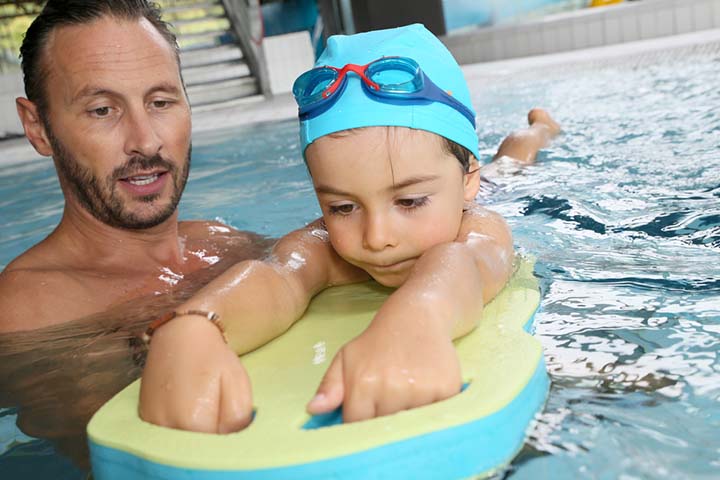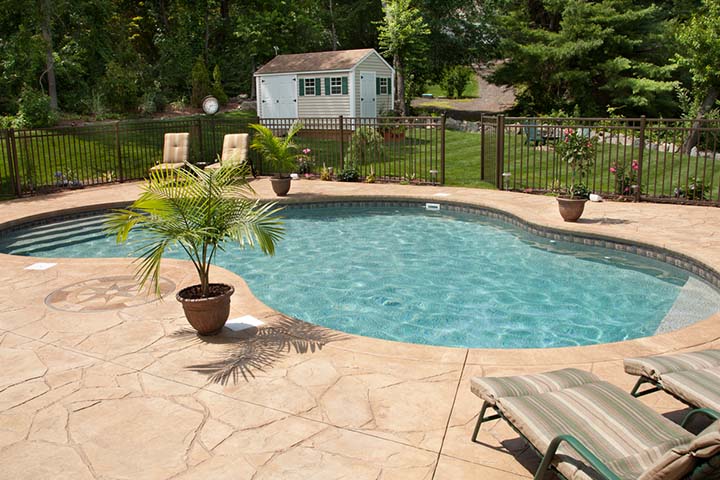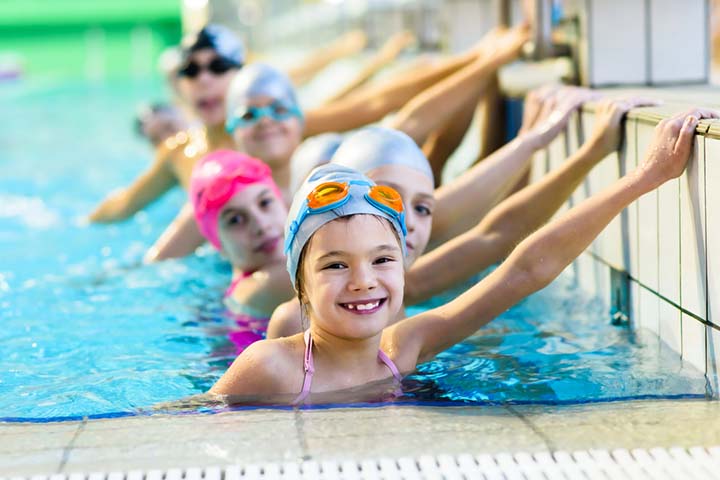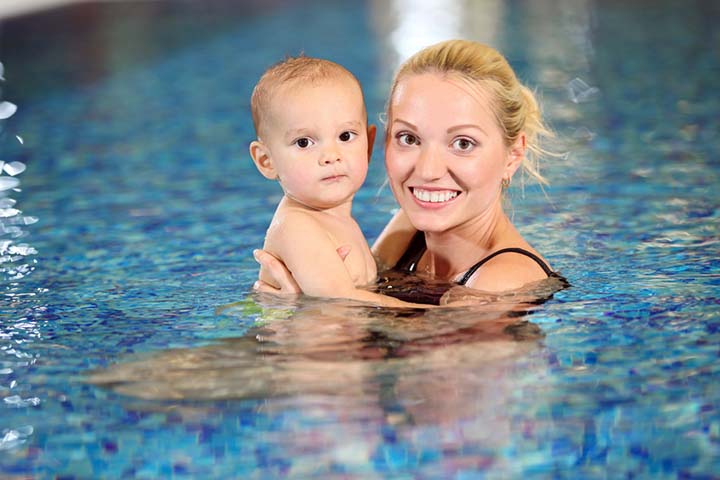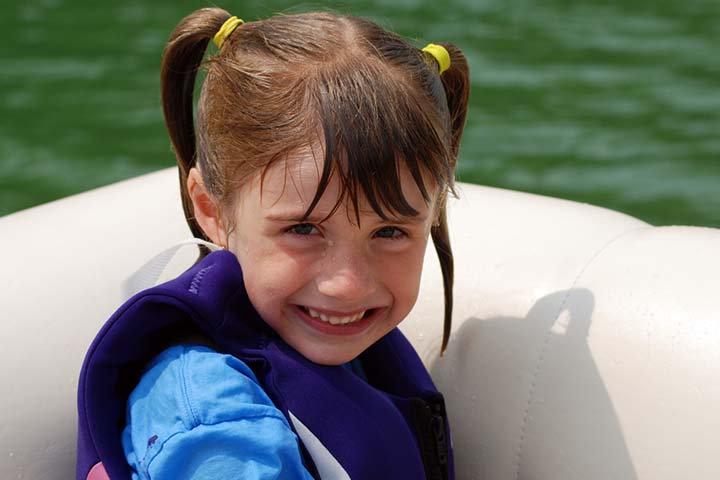
Image: Shutterstock
Swimming is an entertaining and great form of exercise for children. If you are wondering how to teach kids to swim, consider trying the tips given in this post.
Swimming lessons are beneficial as they make a child drown-proof. It is a crucial survival skill that reduces the possibility of your child drowning accidentally. Also, the activity enables your child to streamline their excess energy in a positive direction (1).
At which age should you introduce swimming lessons to children, and what are some of the precautions you should take? Read on as we answer all these questions a parent may have before their child takes their first swimming lesson.
What Is The Best Age To Teach A Child To Swim?
Image: Shutterstock
The right age to teach a child to swim is dependent on several factors such as the physical and mental development of the child, their emotional readiness, their exposure to water, and their comfort. The rate of development may differ from child to child. As per the American Academy of Paediatrics, you could introduce swimming lessons to children when they are as young as four years (1).
 Did you know?
Did you know?Pool Safety: AAP Guidelines
Image: S: iStock
Most water-related deaths of children occur at swimming pools at home. To protect children from drowning in pools, the American Academy of Paediatrics has given some pool safety guidelines (1).
- A child should never be left unsupervised near the pool or a spa.
- Whenever the child under the age of five is in the pool area, they should be constantly supervised by an adult who has complete knowledge of swimming and CPR. The adult should be present at arm’s length from the child.
- Ensure that the necessary safety equipment such as a life saver and shepherd’s hook (long pole with attached hook) made of non-conductiveiXPreventing the flow of heat or electricity material are present near the pool. Also, keep a portable telephone handy for emergencies.
- Avoid keeping inflatable aids (floaties) as they do not safeguard the child against drowning and may be misconceived as protective gear. Instead, arrange for life jacket
- The swimming pool and spa should be the first places to check if a child goes missing.
- The pool should have at least a four-feet high fence on all four sides to prevent the child from getting inside without supervision. There should not be any gaps or openings in the fence through which a child can pass through.
- The fence doors should have a self-latchingiXA gate with a self locking mechanism and self-closing mechanism. The latch should be at enough height to ensure children cannot unlock it.
- Set up an alarm on the gate of the pool. If there is a three-sided fence and your house is on the fourth side of the pool, the alarm should be on the door separating the house and the pool. Underwater alarms and surface wave alarms provide added security. The alarms should be in good working condition and batteries should be fully charged.
- If there is a window facing the pool, ensure that it has a window guard to avoid accidents.
- Even if you have an inflatable backyard pool, ensure that it is surrounded by a fence.
- Pool and spa drains should be compliant with the Pool and Spa Safety Act. Check this before using them. Drains with missing or broken covers can be dangerous for the swim
How To Prepare A Child For Swimming?
Taking certain measures can help your child have fun and look forward to every new swimming session. Here are some tips to prepare your little one for swimming.
1. Address their fear of water
If your child is scared of water, instead of directly putting them in the pool, use these tips and tricks to prepare them for swimming.
- Help them get used to water temperature: Before entering a pool, being used to water temperature might help alleviate some fear. Pour a jug of water maybe.
- Let them spend some time in the bathtub: Let them have fun in the bathtub. Make the bath time enjoyable by blowing bubbles, singing songs, and playing with them.
Image: Shutterstock
- Allow them to explore: After becoming conditioned to the water, the child may slowly start showing excitement for playing in the pool. You may also let them play with swimming goggles during their bath time (shower as well as bathtubs) to help them develop a positive feel of the pool beforehand.
- Let them choose their swimming costumes: This is another way to get them excited for swimming lessons. Take your child shopping for a swimming costume and let them select it (2) . Inform them of the purpose behind buying the costume.
2. Make it a positive experience
Getting involved in some fun activities can boost your child’s excitement for swimming.
- Have a family session: During formal swim lessons, your little one will be surrounded by many people. To get them used to having other people around, you can have a fun pool session with your entire family before the official swim classes begin (2).
- Enjoy some games: You can start by playing shallow-water games, such as I Spy, with your child. In this game, the child can be made to sit at the edge of the swimming pool and find objects around the pool. Another interesting game is red light green light. The green light indicates “kick fast”, the yellow light indicates “kick slow” and the red light indicates “stop”. The host should shout out the light color and children have to act accordingly. A toddler can play whilst sitting in your lap. Learn a few more fun swimming games here.
3. Safeguard your child’s health
These additional tips can make your child’s swimming lessons a smoother experience.
- Ensure they eat a light snack: Swimming requires energy. Hence, prior to the swimming sessions, get your little one to eat some light snacks such as fruits or nuts (2).
- Let them swim with a life jacket: Swimming with a life jacket ensures extra safety for your child. It also helps in swimming by assisting movements such as kicking and pulling.
 Quick fact
Quick factHow To Teach A Child To Swim
1. 1-2 years old
Image: Shutterstock
A 1-2-year-old toddler needs to first get used to the water. So, instead of directly going ahead with swimming lessons, introduce them to water. Playing games, splashing around, and singing songs can help them get comfortable. Get into the water along with them to ensure safety and have fun as well. Start communicating the safe pool habits by showing them how to enter and get out of the pool safely.
Water safety tips
- Keep the baby’s head above the water at all times. Babies are more likely to gulp a lot of water while submerged. Excess water may dilute their normal sodium levels, leading to water intoxication (3). This may cause seizures, coma, brain damage and can be fatal at times (4).
 Trivia
Trivia2. 2 to 3 years old
A two-year-old toddler can be taught to kick their legs and paddle their feet under the water. You can hold them over the water and encourage them to kick as powerfully as they can in the front and back. Teach them the basic skill of floating on their stomach and back with support. Toddlers can get scared when there is water on their faces, so teach them how to blow bubbles underwater. Arm movements can be encouraged by adding floating toys to the water and making the tot reach for them.
Water safety tips
- Toddlers this age are curious and may get away (1) from their parents to explore the water on their own. Hence it is important to keep a constant eye on them whenever water is in the vicinity. Don’t engage yourself in other activities that may distract you (6) while watching your child. Just focus on holding them tight!
- Floating toys, rafts, or water wings may not ensure safety. Invest in a life jacket Check the label to make sure it is U.S. Coast Guard approved (6) Whenever the child is on a boat, inner tube, raft, or near any water body, they should be wearing a life jacket.
- Repeatedly instil in their minds that they can only get into the water when they are accompanied by their parents. They should be taught not to run near the pool or any other water
- If the pool is not being used, toys should not be left lying around the pool and pool area (6). Toddlers may be tempted to go to the pool and reach for the toy if it is left there.
- Whenever you are at a social event, such as a party or picnic, keep an eye out for children if they are in or near any water. In fact, all the parents can take turns to be the “water watchers” (6).
3. 4 to 5 years old
Around the age of four, children start to listen and follow instructions (7). They can also recollect things they learn. All these qualities are great for beginning formal swim lessons. While finalizing the class, ensure that they have professional swim instructors and there is a proper assessment system in place. The classes should allow you to watch the first one (1) or two classes to assess the swimming sessions and safety measures.
Once the training begins, they will soon be able to go into the swimming position from a standing posture and put their head underwater for a few seconds. A 4-year old child can also pick up basic swimming skills such as gliding in the water, floating, and reaching the exit (1). Coordinated leg and arm movements can be gradually developed.
Water safety tips
- The pool should be clean and well-maintained with protective gear and first aid availability. It should have clear demarcationiX The process of setting a boundary or restriction for something indicating the deep and shallow ends of the pool.
- Even if a lifeguard is present, there should be one more person supervising. One guardian should always be within an arm’s distance of the child.
- Not all children progress at the same speed while learning swimming. Your child may take more time than the others, and they may have bad days too. A few little ones might get scared. Don’t force them or get angry. Let them take their time. Be patient and encouraging (7).
4. 6 years old and up
The endurance increases at this age. Six-year-old children can learn front crawl (1). It also becomes possible for them to hold their breath underwater for longer periods and learn different swimming strokes. You could team them with swimming skill such as getting an object from the bottom of the pool or jumping in the water and getting out independently.
Water safety tips
- Visual supervision is important even if your child has already learned swimming. However, you do not need to get into the water with them for extra safety.
- Once children learn swimming, they might try diving. Stress the importance of diving only in the presence of an adult and only in deep water
- Children should wear a life jacket while doing any water-based activities, such as water skiing, rafting, or boating.
Image: Shutterstock
- Swimming in a pool is very different from open water Hence, it is critical to be extra careful while taking your children near open waters such as lakes or beaches even if they know how to swim.
Frequently Asked Questions
1. How do you teach a child to swim who is afraid of water?
If your child is afraid of water, find out the root cause. Try to immerse them a few centimeters at a time if they’ve agreed to give swimming a try. Only proceed with more depth if they’re comfortable. Invest in some fun equipment that could build their enthusiasm. Teach them the benefits of teaching. If your child is hesitant to swim, you may seek professional help.
2. Should I force my child to swim?
Swimming is a crucial life skill. Hence, you may use positive force to encourage them to swim. Try to identify the root cause of their rejection. If they reject again, give them some time and try again later. Only practice gently by highlighting the importance of the activity and by building their confidence (1).
Your kid will be more water-safe when they learn to swim. However, while deciding on ‘how to teach kids to swim,’ you can teach them yourself or enroll them in swimming lessons. But, in both circumstances, you must assure your child’s safety. Even though they have learned to swim, constant supervision is necessary. Swimming classes require organization and effort, but you should also make this activity fun and enjoyable to pique their interests. Play some games, splash around in the water, sing songs, and let them learn at their own pace.
Infographic: How To Find The Right Swimming Instructor For Your Child?
You may be confused about which swim instructor would be the right choice for your child’s safety since you may have received numerous suggestions. So before you enroll your child in the lessons, use these questions below to ease your search and find the best instructor. Illustration: Momjunction Design Team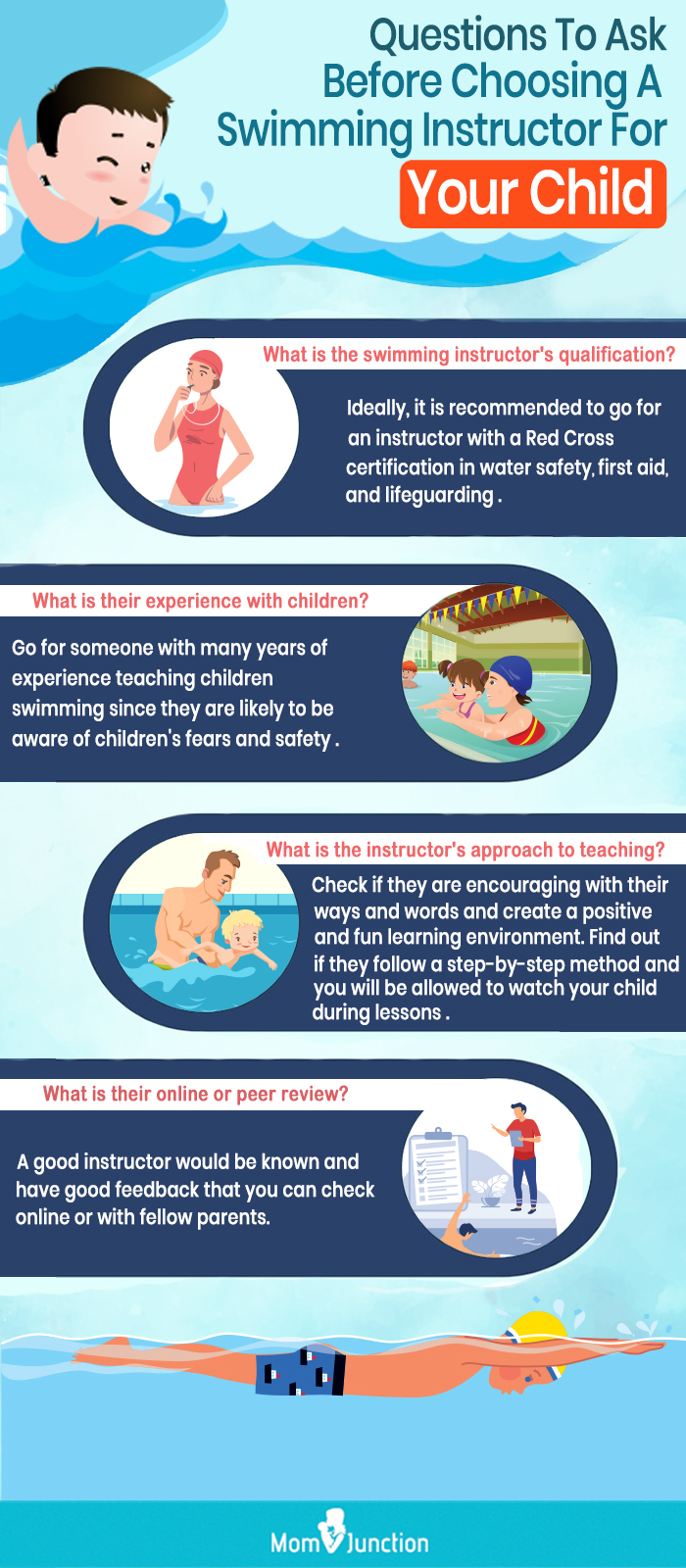
Get high-quality PDF version by clicking below.
Download Infographic
Key Pointers
- Children can start their swimming lessons when they are physically and emotionally ready for it.
- To ensure safety, constantly supervise the child while swimming and install safety equipment and fence around the pool.
- To make swimming enjoyable, allow them to explore the water independently, give them interesting swimming costumes, or play fun games.
- Always consider the age of a child while giving swimming lessons.
References:
- Swim Lessons: When to Start & What Parents Should Know
https://www.healthychildren.org/English/safety-prevention/at-play/Pages/Swim-Lessons.aspx - Learn to swim: Preparing kids for swimming lessons
https://www.swimming.org/learntoswim/preparing-kids-for-swimming-lessons/ - Swimming lessons for infants and toddlers; Paediatrics Child Health (2003).
https://www.ncbi.nlm.nih.gov/pmc/articles/PMC2791436/ - Water Intoxication in Infants
https://www.stlouischildrens.org/health-resources/pulse/water-intoxication-infants - Water safety for children
https://www.betterhealth.vic.gov.au/health/healthyliving/water-safety-for-children - Water Safety for Children Birth to 5 Years
https://www.seattlechildrens.org/globalassets/documents/for-patients-and-families/ce/ce139-water-safety-for-children-birth-to-5-years.pdf - Swimming lessons: 10 things parents should know
https://www.health.harvard.edu/blog/swimming-lessons-10-things-parents-should-know-2018061514064 - Swimming lessons save lives: What parents should know.
https://www.health.harvard.edu/blog/swimming-lessons-10-things-parents-should-know-2018061514064 - Healthy Benefits of Swimming.
https://www.cdc.gov/healthywater/swimming/swimmers/health_benefits_water_exercise.html


